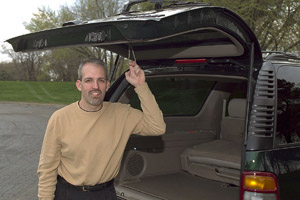|
GM Researcher One of the
World's Top 100 Young Innovators
Work on aluminum forming proves
anything but lightweight
When MIT's Technology Review magazine
recently named their Top 100 Young Innovators for 2002, a
GM Staff Research Scientist and Group Manager in the Materials
and Processes Lab made the list. Paul
Krajewski joins 99 other innovators under the age of 35
whose work in business and technology profoundly impacts today's
world. In Krajewski's case, he is lightening the load for
automobiles by developing new aluminum alloys and forming
methods. To date he's earned six patents, with more pending.
"My work reflects a theme that's
been ongoing since I joined GM - the need to improve formability
of aluminum," says Krajewski. Using aluminum helps
reduce overall vehicle weight, because the metal is 40 percent
lighter than steel. Less weight translates into greater
fuel efficiency for the GM fleet.
But manufacturing vehicles with complex
aluminum parts poses many problems. "If you take a
sheet of aluminum and place it in a die designed for steel,
in many cases the sheet will split during stamping. The
inherent plasticity or formability of aluminum is not as
good as steel," Krajewski explains. "So I've been
involved in two projects: one to develop heat treatments
for aluminum, the other to develop methods for forming at
elevated temperatures."
The Heat Is On
Retrogression heat treatments for aluminum involve applying
temperature in a controlled manner to change the metallurgical
structure and enhance forming. The idea for these heat treatments
originally came from the aluminum ladder industry.
"To make an aluminum ladder, manufacturers
drill holes in the side rails and then heat the ends of
the rungs before inserting them into the holes," says
Krajewski. "They then compress each one, so that all
along the rails are holes with crumpled metal that fits
around the rung ends. That wouldn't be possible without
applying heat - the aluminum would break."
Krajewski's challenge from his supervisor,
Ed Ryntz, was to apply this heat treatment technology to
the auto industry. He spent several years in the laboratory,
working to learn whether these retrogression heat treatments
would work on alloys of interest to the auto industry, what
effect they would have, and where they could best be applied.
Finally, Krajewski learned how to tailor the heat treatments
to automotive-specific alloys.
Armed with this knowledge, he worked with
Ryntz to market the technology within GM, talking with groups
that might benefit from trying a new technique. Eventually
the former Truck Group and Metal Fabrication Division realized
that heat treatments had the potential to solve several
problems they were facing. One of these problems occurred
during hemming, an operation that involves folding the flange
of an outer vehicle panel over an inner panel. Hemming aluminum
panels usually causes it to break at the edge of the bend.
"We focused on a heat treatment for
the Suburban's aluminum liftgate, working with the groups
from the early preproduction stages right up to production,"
says Krajewski. "To ensure that the panel wouldn't
crack during hemming, we developed a small fixture that
provided a heat treatment around the panel just before it
was folded. Later, when the same problem arose during production,
we designed another fixture that could be used in the assembly
process."
The project gave Krajewski a chance to
participate in research and development from start to finish:
"We conducted the lab research, then developed a process
that was used in production. Now, every time I see a Suburban
on the road, I know that work I did impacted part of that
vehicle." (See Figure 1.)

Figure 1. Paul Krajewski, named one
of Technology Review's Top 100 Young Innovators for
2002, shows off a Suburban liftgate manufactured using a heat
treatment process and fixture he developed.
An Unlikely Combination
Krajewski has also been involved in warm forming - conventional
stamping of aluminum at elevated temperatures. For that, however,
he may be best known for developing an improbable new lubricant
using milk of magnesia.
"One of the challenges when you try
to stamp or form things at elevated temperatures is that
many lubricants don't hold up," says Krajewski. "Typical
oils and greases burn away, because they can't tolerate
the high temperatures." Lubricants designed for high
temperatures typically come with a high cost as well.
Krajewski recalled that a friend in graduate
school, Brian Worth, had used milk of magnesia as a release
for elevated-temperature tensile testing. After running
a series of experiments, Krajewski showed that adding inexpensive
milk of magnesia to a more expensive lubricant, such as
boron nitride, produced a fluid that exhibits the best properties
of both.
Ultimately, the breakthrough technologies
Krajewski develops will allow aluminum to be used on a broader
range of GM vehicles, not just on the pricey sports cars.
"We can now build aluminum vehicles with more 'creases
and curves' to excite the eyes of the customer and keep
them happy at the gas pump too," he says.
By Diane Kightlinger
| 



